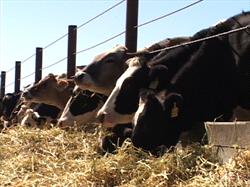Bob Judd, DVM, DABVP (Equine Medicine), DABVP (Canine and Feline Practice)
cowseat2.jpg

When cattle consume hay that is high in nitrates, poisoning can occur. Nitrates are natural chemicals found in soil and include nitrogen and oxygen needed for plant growth. Nitrates can build up in all plants but are more of a concern during drought.
Stress from drought can increase the levels of nitrates in plants unless irrigated. Certain plants are more likely to contain higher levels of nitrates, including pigweed, johnsongrass, corn, sorghum, and Sudan grass, although any plant can contain toxic levels of nitrates.
The publication Drovers.com says that nitrate levels are usually highest in young plants, and typically decrease as the plant matures.
Stressors that cause a decrease in plant growth, such as drought and high temperatures, disease, and herbicide application, can increase nitrate levels in plants.
Nitrate is not especially toxic to cattle when normal levels are consumed. After ingestion, nitrates are converted in the rumen to ammonia and used by microbes as a protein source, but too much nitrite can be toxic as it binds to hemoglobin in the blood and prevents the blood from carrying oxygen. This can result in death in less than four hours after ingesting the toxic plants. The best method to determine if your hay has excessive nitrates is to test it, and there are multiple laboratories, such as the Texas A&M Veterinary Diagnostic Laboratory, that test hay samples.
Your veterinarian can help you process your samples correctly for submission, as there are some specific criteria. Different laboratories test for different compounds, so toxicity levels will depend on the testing method.
Nitrate does not leach out of hay, so even if hay is old, it could still cause nitrate toxicity.